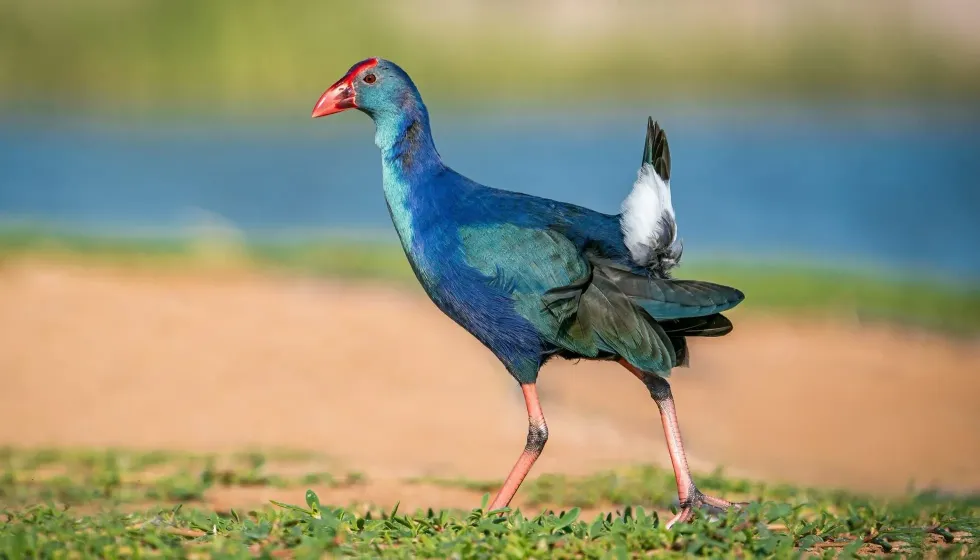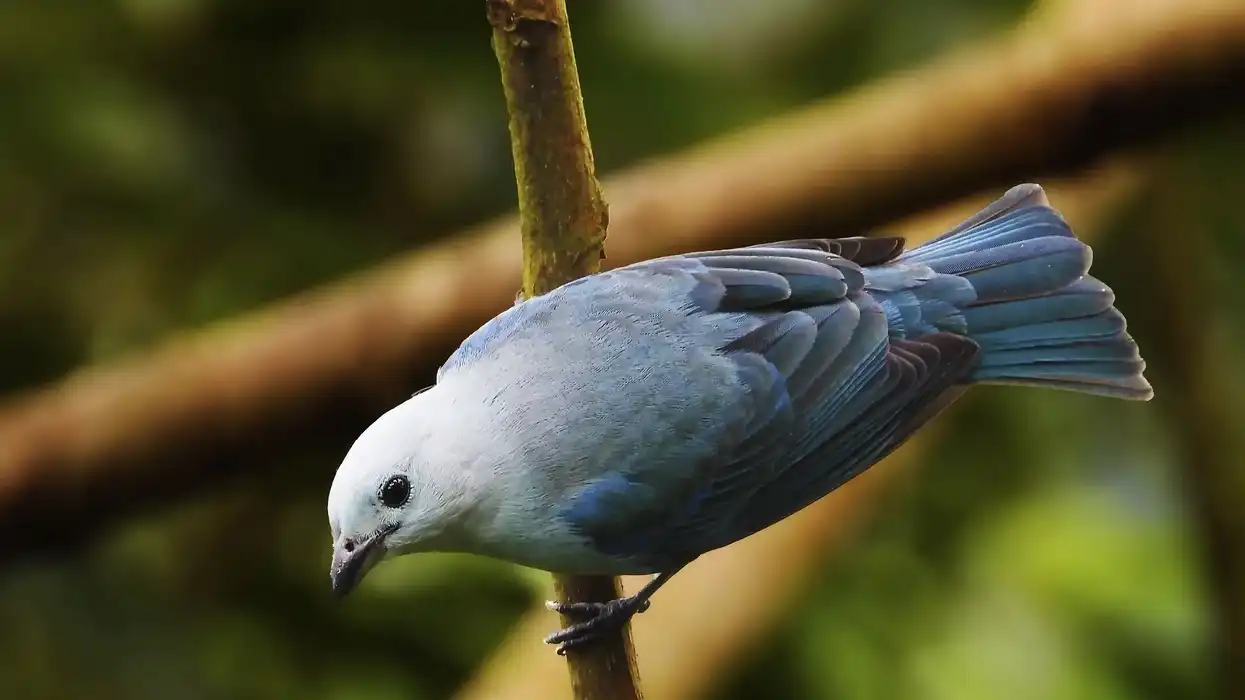What's it like to see a colorful bird walking around the swamps? You must be trying hard to recall. So let's help you enlighten your knowledge with the gray-headed swamphen birds found in the marshlands. Next time you see one it will be easier for you to recognize.
The gray-headed swamphen is a medium-sized bird with huge feet to walk on the swamp, beautifully bright, striking plumage, red bill, and a frontal shield.
Native to southern Asia, these swamp birds have established in Florida's wetlands since 1990. This chicken-sized bird is related to Florida's local purple gallinule and common gallinule.
The gray-headed swamphen was first seen in 1966 in Pembroke Pines. These gray-headed swamphens might have originated from captivity and other birds when hurricane Andrew hit the region in 1992.
It has its distribution in the southeastern region of Florida in North America. The number of these bird species has increased to thousands around the marshlands and ponds of Florida in North America.
Discover the exciting wildlife species of the world in detail. Let us lure you away with the gray-headed swamphen and captivating birds of the world facts like golden-crowned sparrow facts and pink cockatoo facts.
Gray Headed Swamphen Interesting Facts
What type of animal is a gray headed swamphen?
The gray-headed swamphen, Porphyrio poliocephalus, lives in pairs and large communities. The gray-headed swamphen, Porphyrio poliocephalus, in some countries show social behavior and are monogamous, and some even show cooperative breeding.
In cooperative breeding, there are multiple females and males that share a nest. Also, male-female breeding pairs are helped by adult birds from the previous clutch.
The Porphyrio poliocephalus breeds according to season. Therefore, seasonal breeding varies according to the habitat. They breed during peak rainfall in many regions or during the summer months in the temperate regions.
The swamphens like to breed in the warm reed beds of the marshlands. The males display their courtship by holding water reed in their bill and bowing to the female with a loud chuckling sound. The Porphyrio poliocephalus species are known to be strong swimmers.
What class of animal does a gray headed swamphen belong to?
The gray-headed swamphen class, family, and genus are listed as class Aves, family Rallidae, genus Porphyrio. It comes under the subspecies of the purple swamphen.
How many gray headed swamphen are there in the world?
The exact population of gray-headed swamphens is not known. However, its population is distributed widely in the Middle East, Southeast Asia, and Southwest Asia.
The gray-headed swamphen, Porphyrio poliocephalus, is one of the six species of the purple swamphen. In 2015, the purple swamphen was given complete species status. Today the purple swamphen, Porphyrio, is considered a superspecies or mother species of the other six swamphen subspecies.
Where does a gray headed swamphen live?
The gray-headed swamphen, Porphyrio poliocephalus, lives in the wetlands or swamps, rivers, and lakes in small groups. Porphyrio poliocephalus, the gray-headed Swamphen, is found in the Middle East, India, and its subcontinent to the south of China and northern Thailand.
In Thailand, you can get a glimpse of the Porphyrio poliocephalus in Thale Noi Wildlife Refuge and Nong Bong Kai Wildlife Refuge.
The gray-headed swamphen is endemic or native to the wetlands of southern Asia. In Southern Asia, they are found in the Indian sub-continent. In India and its subcontinent, it is found in the lower Himalayan valleys to the south of India and Sri Lanka and from north and central Pakistan to Myanmar.
In its native Southeast Asia, they are found in Sumatra, central Turkey, and north to south China. In the southwest part, it is spread along with the Black Sea, the Caspian Sea, the Mediterranean Sea, and the Tigris and the Euphrates to the Persian Gulf.
In the old world, they are distributed from south of Europe to south of Africa and New Zealand.
What is a gray headed swamphen's habitat?
The gray-headed swamphen's habitat comprises swamps or wetlands. They usually breed in the reed beds behind the bushes and hyacinths to keep out of sight of predators.
The brackish and freshwater swamps with much vegetation like sedges (Carex), reeds (Phragmites), and reedmace (Typha) are habituated by the swamphens. The gray-headed swamphen (P.poliocephalus) prefers wetlands or swamps with constant water levels.
In the Indian subcontinent, they are sometimes found in pastures. The gray-headed swamphen (P.poliocephalus) species dwell in this type of habitat and are not interested in living in the woods and forests. Populations vary according to their habitats.
Who do gray headed swamphens live with?
The gray-headed swamphen lives in groups with their families.
How long does a gray headed swamphen live?
The lifespan of the gray-headed swamphen is not recorded.
How do they reproduce?
The gray-headed swamphen's (P poliocephalus) mating system varies and ranges from monogamous to cooperative mating. In monogamous breeding, one male and female form a breeding pair and may remain together throughout the breeding season to reproduce. In cooperative breeding, multiple females and males share their nests to copulate, and helpers from the previous clutch help the male-female breeding pair.
Dominance hierarchy exists in these bird groups- a dominant female breeds the most. The birds lay their eggs in a nest built from woven reeds. A female lays up to seven eggs, and a nest may contain up to 12 eggs. More than one female is responsible for incubating the eggs for 24 days.
What is their conservation status?
The conservation status of the gray-headed swamp (Porphyrio poliocephalus) is of Least Concern according to the IUCN.
Gray Headed Swamphen Fun Facts
What do gray headed swamphens look like?
Listed as one of the astonishing birds of the world, the gray-headed swamphen has striking features with plumage of blue ranging from turquoise to violet, purple, and indigo. In addition, its coloration pattern varies even within the same population.
The gray-headed swamphen is a medium-sized bird with long legs, a heavy frontal bill, and a horned triangular forehead comprising multiple shades of red, from pale pink to orange-red to brownish and black. Their legs are pink, and their joints, like their knuckles, wrists, and knees, are dark.
How cute are they?
Gray-headed swamphens (Porphyrio poliocephalus) are cute and vibrant medium-sized birds with a blue and purple gallinule with a red bill and red triangular forehead shield. The tail is short, often flicked up, and its underparts are white. Baby swamphens are duller than the adults and don't have the red bill or the red forehead shield.
How do they communicate?
The gray-headed swamphen (Porphyrio poliocephalus) communicates visually and through vocal sounds. They make croaking sounds and short nasal grunting. However, their call varies. They make shrieking calls to warn others when being attacked. Humming calls are mostly made during courtship.
How big is a gray headed swamphen?
The gray-headed swamphen is 11.02-11.41 in (28 - 29 cm) in length. Therefore, the gray-headed swamphen is half the size of the common hen.
How fast can a gray headed swamphen fly?
Gray-headed swamphens are not fast flyers, but they run fast even on the swamp. Unfortunately, they are mostly known to fly clumsily. Their exact flight speed is not mentioned.
How much does a gray headed swamphen weigh?
The gray-headed swamphen's weight is not mentioned. However, its weight is almost equal to that of a common hen.
What are the male and female names of the species?
There are no sex-specif names for gray-headed swamphens.
What would you call a baby gray headed swamphen?
The baby gray-headed swamphen is known as a chick.
What do they eat?
Gray-headed swamphens (Porphyrio poliocephalus) are omnivorous. However, they are often found to feed clumsily, mostly on the vegetable matter found in the swamp waters like reeds, leaves, stems, roots, shoots, floating vegetation, and other aquatic plants.
The Porphyrio poliocephalus sometimes eat small fish, tiny frogs, snails, bird eggs, small birds, and ducklings. Their long red toes balance their weight and walk around floating marshland plants.
Are they dangerous?
No, the gray-headed swamphen is not dangerous.
Would they make a good pet?
Yes, the Porphyrio poliocephalus would make a good pet. However, they would best be suited to keep as a pet in farmlands with swamps.
Did you know...
The gray-headed swamphen does not migrate. Instead, it appears that the Porphyrio poliocephalus seem to enjoy their life in the habitat they have found.
In the wildlife of Florida's freshwater marshes, the Porphyrio poliocephalus seems to like the environment. By 2011, the Porphyrio poliocephalus were found in 30 different spots in Florida. They have expanded their range as far as Georgia, around 423 miles away from the Pembroke Pines.
In their native range in Asia, the Porphyrio poliocephalus do not migrate. Mostly, it expands its range only when the water level rises.
How many eggs do gray headed swamphens lay?
The Porphyrio poliocephalus females lay around three to seven eggs. A nest may consist of up to 20 eggs since multiple females lay in the same nest.
The eggs are usually a tan or yellowish-beige color with dark brown spots. More than one female incubates the nest eggs for around 24 days. The chicks are fed by the adults first for several weeks until they mature.
How to tell a gray headed swamphen from other birds?
You can distinguish the gray-headed swamphen populations from the other bird species like Common moorhen (Gallinula chloropus) by its bigger size. The P. poliocephalus has purple-blue plumage, red bill, red horned forehead, its tail is raised with white underparts, and the end of the wings are smudged black or brown.
The gray-headed swamphen is also treated as a subspecies of the purple swamphen, which has a distribution from southern Europe to South Africa and New Zealand. There are around six subspecies of purple swamphen. Each of the purple swamphen species has its identification patterns.
For example, the European purple swamphen is purple-blue. The South Asian and African purple swamphen has a green back. The Indonesian and Australian swamphens have black backs and heads.
Here at Kidadl, we have carefully created lots of interesting family-friendly animal facts for everyone to discover! Learn more about some other birds including jackdaw facts or verdin facts.
You can even occupy yourself at home by coloring in one of our free printable gray headed swamphen coloring pages.










